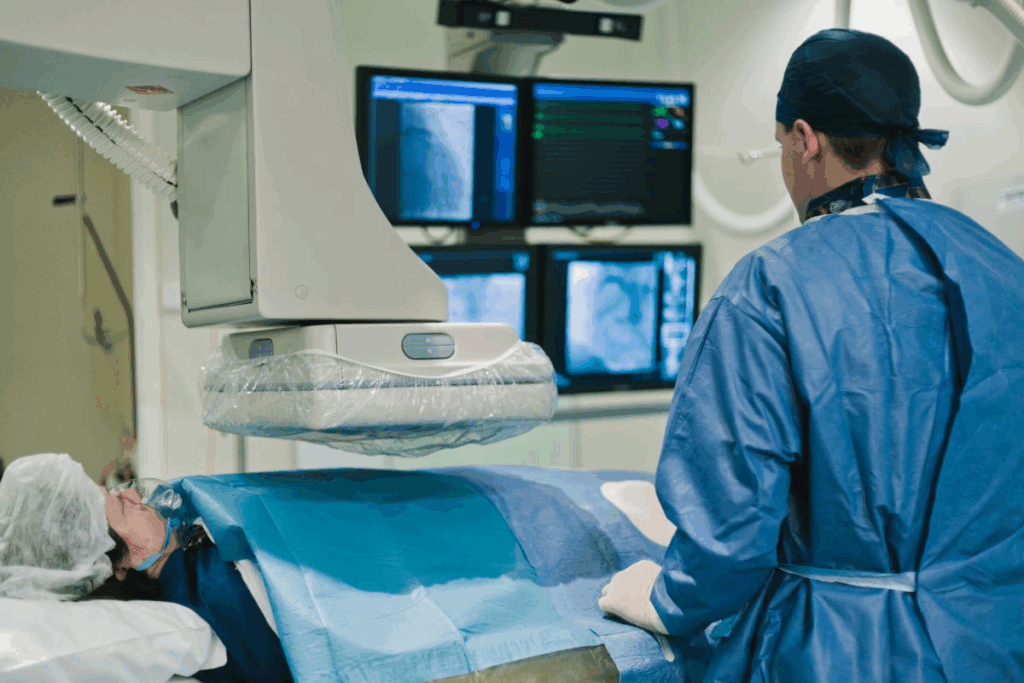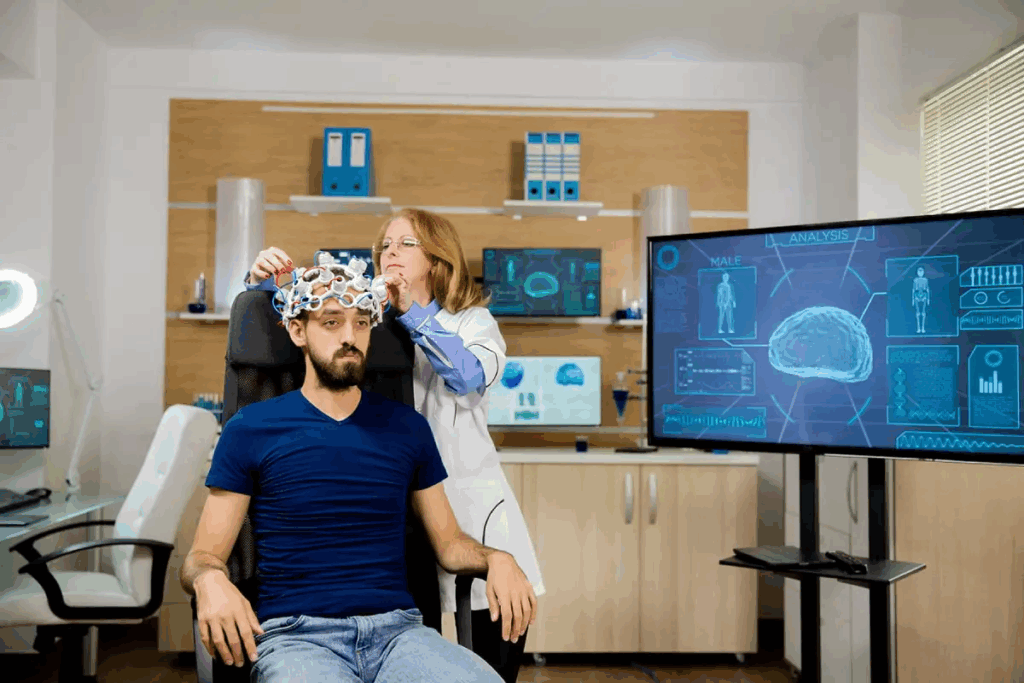Last Updated on October 23, 2025 by mcelik

Treating brain aneurysms needs a mix of cutting-edge tech and caring hands. The coil embolization procedure is a key method. It’s a small, non-invasive way to tackle brain aneurysms.
We use endovascular coiling to treat brain aneurysms. We put platinum aneurysm coils in the weak spot. This stops blood flow and lowers the risk of rupture. Johns Hopkins Medicine says it works by blocking blood flow into the aneurysm.
We aim to give a full look at the coil embolization procedure. We talk about its benefits and what patients can expect. By using the latest tech and caring for each patient, we set new standards in brain aneurysm treatment.

It’s important to know about brain aneurysms to understand their risks and treatment options. These medical conditions can be serious if not handled right.
A brain aneurysm is a weak spot in an artery’s wall. It can swell or burst, which is very dangerous. Getting medical help quickly is key.
Some things can make an aneurysm more likely to burst. These include high blood pressure, smoking, and a family history of aneurysms. Knowing these risks helps doctors figure out the best treatment.
The signs of brain aneurysms can vary. They often include headache, neck pain, and nausea. Sometimes, there are no symptoms until it bursts, causing a subarachnoid hemorrhage. Spotting these signs early is vital for quick medical care.

Brain aneurysm treatment has changed a lot over time. This change comes from new medical tech and methods. Now, we have better and less scary ways to treat brain aneurysms.
Old treatments for brain aneurysms included clipping the aneurysm. This stops blood from flowing into it. But, it needs a big surgery and can have risks.
Surgical clipping was once the top choice. It works well but has downsides. These include needing to be under general anesthesia and a long recovery time.
New endovascular techniques have changed brain aneurysm treatment. Coiling is a big part of this. It’s a small procedure that uses coils to stop the aneurysm from bursting.
Today, doctors often choose coiling because it’s less invasive. It also has fewer risks than clipping. The choice between clipping and coiling depends on the aneurysm and the patient’s health.
| Treatment Modality | Advantages | Disadvantages |
| Surgical Clipping | Definitive treatment, long-term outcomes | Invasive, risk of brain injury, longer recovery |
| Endovascular Coiling | Minimally invasive, reduced risk of complications, shorter recovery | Potential for coil compaction, need for follow-up |
Brain aneurysm treatment is always getting better. Scientists are working on new ways to treat them. They aim to make treatments safer and more effective.
Coil embolization is a minimally invasive way to treat brain aneurysms. It involves placing platinum coils into the aneurysm sac. This method is part of endovascular therapy, focusing on treating vascular disorders without open surgery.
This technique stops blood flow into the aneurysm, lowering the risk of rupture. A microcatheter is guided through blood vessels to the aneurysm. There, platinum coils are released to fill the sac.
Coil embolization, or endovascular coiling, uses platinum coils to stop blood flow into an aneurysm. The goal is to fill the aneurysm with coils, causing clotting. This eventually blocks the aneurysm from the blood flow.
The coils are made of platinum, a safe material for the body. They help in clotting the aneurysm, preventing rupture.
Not every aneurysm can be treated with coil embolization. The size, shape, and location of the aneurysm matter. Small to medium-sized aneurysms with a narrow neck work best for coiling.
We examine each aneurysm individually. Imaging like angiography helps us decide if coiling is right.
| Aneurysm Characteristics | Suitability for Coiling |
| Small to medium size | Highly suitable |
| Large size | May require additional techniques |
| Narrow neck | Highly suitable |
| Wide neck | May require stent-assisted coiling |
Coil embolization is not for everyone. Allergies to platinum or complex anatomy can make it hard. We check each patient for these issues before starting.
Our goal is to make sure the procedure is safe and effective for each patient.
Medical coils and devices are key in treating aneurysms. They have evolved a lot, making treatments better for patients.
Aneurysm coils fill the aneurysm sac, helping it clot and stop blood flow. There are many types, including:
Catheters are used to put coils into aneurysms. They are made to safely go through the brain’s blood vessels.
Microcatheters are used to place coils in the aneurysm. They are flexible and can go through tight spots.
For tough cases, extra devices are needed. This is true for complex or wide-necked aneurysms.
These tools and methods have made it possible to treat more aneurysms. They offer safer and less invasive options for patients.
We prepare patients for coil embolization with a detailed pre-procedure assessment and the best anesthesia options. This careful preparation is key for the procedure’s success.
Before the procedure, patients get a thorough check-up to spot any risks. We look at their medical history, current meds, and allergies. We also do imaging studies to understand the aneurysm and plan the best approach.
Choosing the right anesthesia is vital for patient comfort and procedure success. For coil embolization, we usually pick between general anesthesia and conscious sedation. General anesthesia is best for complex cases or when precise control is needed. Conscious sedation keeps patients comfortable and somewhat awake, which suits some patients better.
After anesthesia, we position the patient on the angiography table. They lie flat on their back, secured to prevent movement. The angiography equipment is set up around them for clear imaging of the aneurysm site. This setup is essential for accurate coil placement during the procedure.
By managing patient preparation and anesthesia well, we improve the safety and success of the coil embolization procedure.
Coil embolization for brain aneurysms involves several key steps. We’ll walk you through from accessing the vascular system to deploying coils with a microcatheter.
The first step is gaining vascular access. This is done through a femoral artery approach in the groin. A small incision is made to access the artery. We use the Seldinger technique to insert a sheath, allowing for catheter and device introduction.
With vascular access established, we navigate to the aneurysm site. We use guidewires and catheters with fluoroscopic guidance for precise placement. Roadmap techniques help navigate complex anatomy.
At the aneurysm site, we perform a detailed angiographic assessment. We evaluate the aneurysm’s size, shape, and neck characteristics. This helps choose the right coil size and type. 3D angiography gives us a full view of the aneurysm’s geometry.
The next step is placing a microcatheter in the aneurysm. We carefully position the microcatheter in the aneurysm sac. It’s the path for coil delivery, filling the aneurysm to stop blood flow.
During the procedure, we watch the patient’s neurological status closely. We adjust our technique as needed for the best outcome. These steps help us treat brain aneurysms with endovascular coiling.
Endovascular coiling has evolved, leading to new ways to treat brain aneurysms. These new methods have made treatments more effective and safer for patients.
Balloon-assisted coiling helps with wide-necked aneurysms. A balloon is inflated across the aneurysm neck. This stops coils from moving into the main artery, making the treatment more stable.
This method is great for aneurysms that are hard to treat with regular coiling.
Stent-assisted coiling uses a stent to hold coils in place. It’s good for wide-necked aneurysms because it stops coils from moving and helps close the aneurysm. This technique is a key tool for complex aneurysm treatment.
Flow diversion is a new method using a stent to change blood flow. It helps the aneurysm to clot off while keeping the main artery open. It’s shown great promise for treating tough and giant aneurysms.
Wide-necked aneurysms are hard to treat because it’s hard to keep coils in place. Techniques like balloon-assisted and stent-assisted coiling have helped a lot. They add support and stability, improving treatment outcomes for these aneurysms.
As we keep improving endovascular coiling, these techniques will be key in treating brain aneurysms. By using new technologies and our expertise, we can give our patients the best care.
It’s important to know about the risks of coil embolization for brain aneurysms. This treatment is very effective but comes with some dangers.
During coil embolization, serious problems can happen. These include thromboembolic events, aneurysm rupture, and coil migration. Thromboembolic events are a big worry because they can cause strokes or serious brain problems.
“Thromboembolic complications are a major concern during neuroendovascular procedures, requiring meticulous preventive measures and prompt management.”
To lower these risks, we use advanced methods and tools. For example, balloon-assisted coiling and stent-assisted coiling help keep the coil in place and reduce risks.
After coil embolization, problems can also arise. These include vasospasm, coil compaction, and recurrence of the aneurysm. Vasospasm is a big worry because it can cause delayed brain ischemia. It’s important to watch patients closely and follow up to catch and treat these issues early.
Having emergency plans ready is key for handling problems during and after coil embolization. Our plans include quick access to neurointerventional devices and pharmacological agents for any issues. For example, if an aneurysm ruptures, we have fast action plans, like using reversal agents and emergency coiling techniques.
Managing complications well needs a team effort. Neurointerventionalists, neurologists, and other healthcare experts all play a part. Knowing the risks and having strong emergency plans helps us give the best care to patients getting coil embolization.
After a coil embolization procedure, patients start a critical recovery phase. This phase needs careful monitoring and care. It’s key for the treatment’s success and the patient’s health.
Patients are watched closely in a recovery area for hours after the procedure. We check vital signs, brain function, and look for complications. This helps us spot and fix any issues quickly.
Key aspects of immediate post-procedure care include:
We give patients detailed care instructions before they go home. These cover medication, wound care, and signs of complications. Following these instructions helps ensure a smooth recovery.
It’s important for patients to understand:
We advise patients on activities to avoid after the procedure. This includes no heavy lifting, bending, or strenuous activities for a while.
Typical activity restrictions include:
A follow-up schedule is key for post-procedure care. We schedule appointments to check the aneurysm, see how the procedure worked, and address any concerns.
Follow-up care typically involves:
Following the post-procedure care and recovery guidelines helps patients have the best chance of success after coil embolization for brain aneurysm treatment.
Endovascular coiling is a big step forward in treating brain aneurysms. It brings many benefits that improve patient care. This method has led to better results for patients because it’s less invasive.
Endovascular coiling greatly reduces the risks of the procedure. It avoids open surgery, which means less damage to tissues and fewer complications. Research shows it has fewer side effects than traditional surgery.
Patients who get endovascular coiling usually stay in the hospital less and recover faster. This is because the procedure is less invasive. So, they can get back to their daily lives sooner.
“The minimally invasive nature of endovascular coiling significantly reduces the recovery time for patients, allowing them to return to their daily lives more quickly.”
Choosing the right patients for endovascular coiling is key. The size, location, and shape of the aneurysm are important. These factors help decide if coiling is the best option.
| Patient Characteristics | Ideal for Coiling | Not Ideal for Coiling |
| Aneurysm Size | Small to medium | Large or giant |
| Aneurysm Location | Accessible locations | Difficult-to-reach locations |
Looking at long-term results, endovascular coiling often matches or beats surgical clipping. The success of coiling has grown with new technology and techniques.
We keep watching and studying long-term results. This helps us improve how we treat brain aneurysms.
Coil embolization is a key treatment for brain aneurysms. It’s a less invasive method with good results. This procedure helps treat aneurysms, lowering the chance of rupture and improving patient health.
The endovascular coiling method has changed how we treat brain aneurysms. It’s a less invasive choice compared to old surgical ways. We use coils to block blood flow into the aneurysm, helping it clot.
As we keep improving in endovascular neurosurgery, coil embolization’s role will grow. It will open up new ways to care for patients. Our goal is to provide top-notch healthcare and support to patients worldwide.
Coil embolization is a procedure to treat brain aneurysms. It uses coils to fill the aneurysm, helping it clot and preventing rupture.
Endovascular coiling uses a tiny catheter to reach the aneurysm. Coils are then placed inside to block blood flow and promote clotting.
Coil embolization is less invasive than traditional surgery. It has lower risks and can lead to shorter hospital stays.
Small-necked aneurysms in accessible areas are good candidates for coiling. Each case is evaluated individually.
Risks include aneurysm rupture, coil migration, and vasospasm during the procedure. Post-procedure, complications like stroke or coil compaction can occur.
The procedure starts with a small incision in the groin. A microcatheter is guided to the aneurysm, where coils are deployed.
Devices like balloons and stents help make coil embolization more effective. They’re used for complex aneurysms.
Patients are closely monitored in the hospital and then follow a recovery plan. This includes activity limits and follow-up appointments.
Preparing involves assessments and instructions on pre-procedure care. You’ll also be positioned for the procedure under anesthesia.
Long-term, outcomes are usually good, with a low risk of rupture and high occlusion success rate. Regular follow-ups are needed, though.
Coil embolization is a minimally invasive procedure. Surgical clipping is open surgery. Coil embolization is often safer.
No, not all aneurysms can be treated with coil embolization. It depends on the aneurysm’s size, shape, location, and neck size.
References:
Subscribe to our e-newsletter to stay informed about the latest innovations in the world of health and exclusive offers!
WhatsApp us